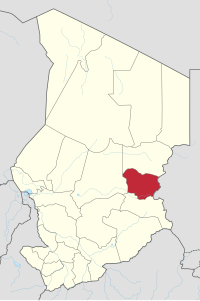Ouaddaï Region
13°49′48″N 20°49′58″E / 13.83°N 20.8328°E
Ouaddaï
وداي | |
|---|---|
 Map of Chad showing Ouaddaï. | |
| Country | |
| Departments | 3 |
| Sub-prefectures | 16 |
| Regional capital | Abéché |
| Population (2009)[1] | |
• Total | 721,166 |
Ouaddaï or Wadai (Arabic: وداي) is a region of Chad, located in the south-east of the country, with its capital at Abéché. Prior to 2002 it was known as Ouaddaï Prefecture; in 2008 the southern portions of Ouaddaï (the Sila Department and Djourf Al Ahmar Department) were split off to become the new Sila Region (also known as Dar Sila).[2]
History
[edit]The region was the heartland of the former Ouaddai Empire, or Wadai Sultanate, which existed from the early 16th century until 1911 when it was conquered by France in the Ouaddai War. Both capitals of the Empire - Ouara (now uninhabited) and Abéché - are located in modern Ouaddaï region.
Geography
[edit]The region borders Wadi Fira Region to the north, Sudan to the east, Sila Region to the south, and Batha Region to the west. The terrain is generally flat savannah, rising slightly towards the east where the Ouaddaï highlands are located.
Settlements
[edit]Abéché is the capital of the region and is the fourth largest city in Chad; other major settlements include Abdi, Adré, Am Hitan, Bourtail, Chokoyan, Hadjer Hadid, Marfa, Mabrone and Tourane.[3]
Demography
[edit]As per the 2009 Chadian census, the region has a population of 721,166.[1] The main ethnolinguistic groups are the Assangori, Baggara (generally speakers of Chadian Arabic), Dar Sila Daju, Kajakse, Karanga, Kendeje, Maba (including the Marfa sub-group), Mararit, Masalit and Surbakhal.[4]
Subdivisions
[edit]Since 2008, the region of Ouaddaï is divided into three departments:
| Department | Capital | Sub-prefectures |
|---|---|---|
| Abdi | Abdi | Abdi, Abkar Djombo, Biyeré |
| Assoungha | Adré | Adré, Hadjer Hadid, Mabrone, Borota, Molou, Tourane |
| Ouara | Abéché | Abéché, Abougoudam, Chokoyan, Bourtaïl, Amleyouna, Gurry, Marfa |
References
[edit]- ^ a b DEUXIEME RECENSEMENT GENERAL DE LA POPULATION ET DE L’HABITAT: RESULTATS GLOBAUX DEFINITIFS (PDF) (Report). INSEED. March 2012. p. 24. Archived from the original (PDF) on 24 September 2015. Retrieved 10 March 2017.
- ^ "Ordonnance n° 002/PR/08 portant restructuration de certaines collectivités territoriales décentralisées" [Ordinance No. 002/PR/08 on restructuring of certain decentralized local authorities]. Government of Chad. 19 February 2008. Archived from the original on March 4, 2016.
- ^ "Tchad : Région du Ouaddai - Juin 2010" (PDF). UNOCHA. Retrieved 27 September 2019.
- ^ "Languages of Chad". Ethnologue. Retrieved 27 September 2019.